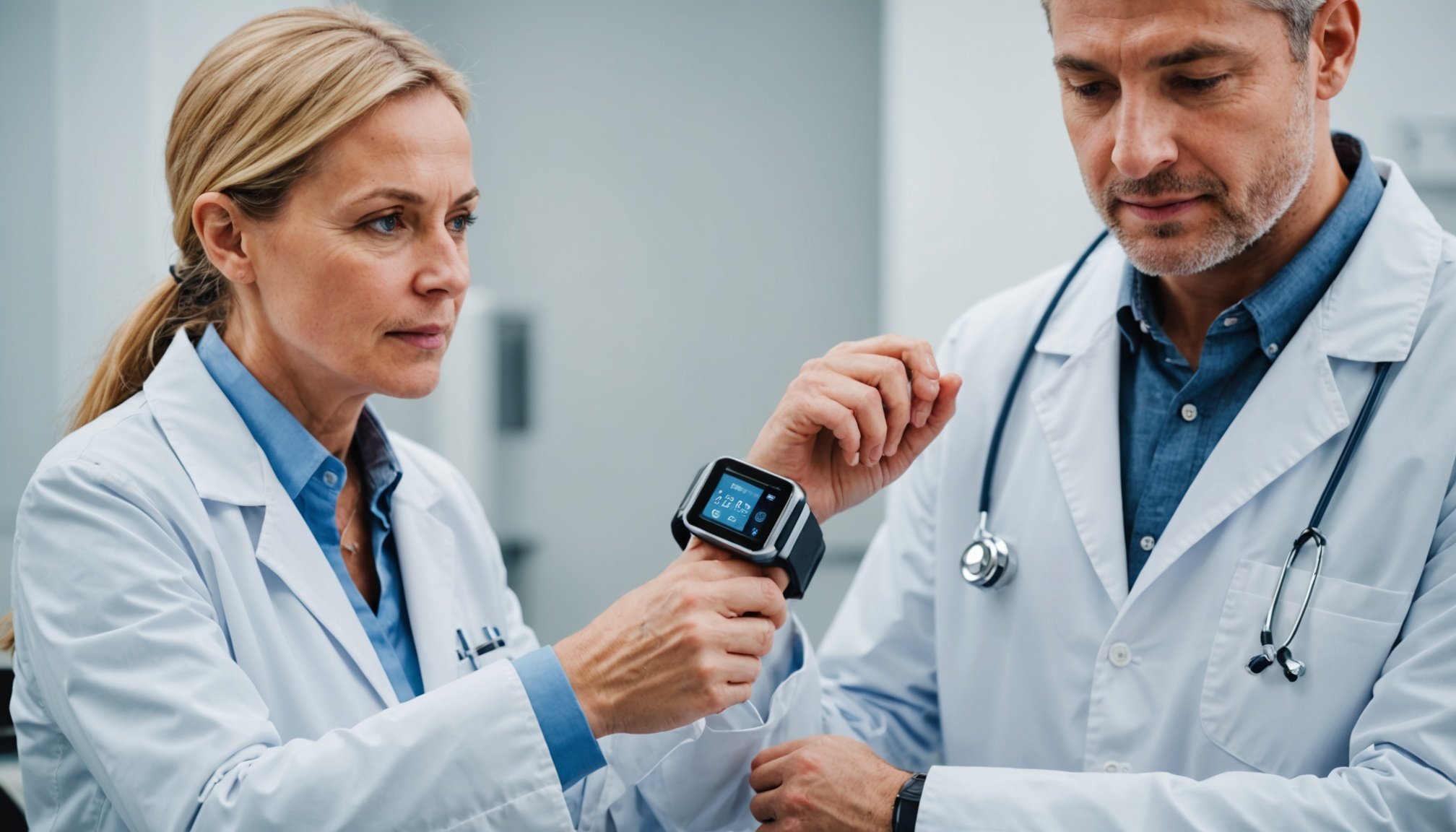Revolutionizing Patient Care: How Wearable Tech is Shaping Healthcare Monitoring in the UK
The Rise of Wearable Technology in Healthcare
In the UK, the healthcare landscape is undergoing a significant transformation, driven largely by the integration of wearable technology. These innovative devices are not just tracking steps and heart rates; they are revolutionizing the way healthcare is delivered, monitored, and managed.
Wearable devices, such as smartwatches, fitness bands, and advanced sensors, are becoming indispensable tools for both patients and healthcare providers. These devices collect vital data continuously, providing real-time insights into a patient’s health. For instance, wearables can monitor heart rate, blood pressure, sleep patterns, and even stress levels, making healthcare more accessible and proactive[2].
Also read : What are the best sustainable home improvement ideas in the UK?
Real-Time Health Monitoring and Its Impact
One of the most significant advantages of wearable technology is its ability to provide real-time health monitoring. This feature allows healthcare providers to catch potential health issues before they escalate. Here are some ways real-time monitoring is making a difference:
- Early Detection: Wearables can detect irregular heartbeats, high blood pressure, and other critical health indicators in real time. This early detection can be lifesaving, especially for conditions like coronary artery disease (CAD), which is the UK’s biggest killer[1].
- Remote Patient Monitoring: With wearable devices, patients can be monitored remotely, reducing the need for frequent clinic visits. This is particularly beneficial for patients with chronic conditions or those living in underserved areas[5].
- Personalized Care: Real-time data from wearables enables healthcare professionals to create personalized care plans. For example, a mobile app can help patients prepare for joint replacement surgery by tracking their resistance training exercises and providing personalized feedback[1].
Innovations in Digital Health: The South Yorkshire Digital Health Hub
The South Yorkshire Digital Health Hub (SYDHH) is at the forefront of this digital health revolution. Led by the University of Sheffield and Sheffield Hallam University, this hub has secured £500,000 in funding for seven innovative projects aimed at addressing health inequalities in the region.
Also to discover : How Did Recent Political Changes in the UK Impact Daily Life?
These projects leverage data from smartphones, wearables, and sensors combined with NHS data to create novel clinical tools. For instance, one project focuses on developing simple, quick tests for diagnosing coronary artery disease (CAD) in local communities, reducing the need for costly tests like CT scans and ensuring equal access to care[1].
Biometric Wearables and Their Role in Healthcare
Biometric wearables are a key component of this technological shift. These devices track physiological data, providing insights that were once only available in a doctor’s office. Here are some ways biometric wearables are impacting healthcare:
- Advanced Health Metrics: Biometric wearables can track ECG, stress levels, and hydration, among other metrics. This comprehensive data helps patients and healthcare providers understand health at a deeper level[2].
- Continuous Monitoring: Devices like the GENEActiv and ActivInsights Band offer long-term, continuous monitoring of activity, sleep, and lifestyle. These devices capture real-world data, enabling researchers to uncover hidden patterns and correlations that can lead to breakthroughs in clinical care[3].
Transforming Healthcare Pathways with Mobile Technologies
Mobile technologies, including wearable devices, are optimizing healthcare pathways in several ways:
- Pre-Surgery Preparation: Mobile apps can help patients prepare for surgeries like joint replacement by monitoring their exercises and providing feedback. This reduces the need for frequent in-person visits and empowers patients to take a more active role in their recovery[1].
- Remote Monitoring: Mobile systems enable real-time monitoring of patient progress, allowing for timely interventions and personalized care. This approach saves time and resources while improving patient outcomes[2].
Addressing Workplace Health and Safety with Wearable Technology
Wearable technology is not only transforming patient care but also revolutionizing health and safety in the workplace. Here’s how:
- Musculoskeletal Injury Prevention: Wearable technologies like the Modjoul SmartBelt and Ansell’s Inteliforz track unsafe movements and hand and wrist movements, helping to prevent musculoskeletal disorders (MSDs). These devices provide real-time feedback, enabling workers to develop good ergonomic habits[4].
- Exoskeleton Solutions: Exoskeleton suits are being used to protect workers from high-impact repetitive activities. These suits, combined with AI algorithms, analyze tasks like lifting and carrying, reducing the risk of injury and improving workplace safety[4].
Challenges and Future Directions
While wearable technology holds immense potential, there are challenges to be addressed:
- Data Accuracy and Privacy: Ensuring the accuracy of the data collected and addressing privacy concerns are crucial for the widespread adoption of wearable technology in healthcare[5].
- Integration into Healthcare Systems: Seamless integration of wearables into existing healthcare systems is necessary to fully realize their benefits. This includes addressing issues like interoperability and data management[5].
Practical Insights and Actionable Advice
For those looking to leverage wearable technology in healthcare, here are some practical insights:
- Choose the Right Device: Select wearables that are validated and proven, such as those used by the South Yorkshire Digital Health Hub or ActivInsights. Ensure they meet your specific health monitoring needs[1][3].
- Ensure Data Security: Always prioritize data security and privacy. Use devices and platforms that adhere to strict data protection standards[5].
- Integrate with Telemedicine: Combine wearable technology with telemedicine for comprehensive remote patient monitoring and rehabilitation. This is especially beneficial for patients in underserved areas[5].
Table: Comparison of Wearable Devices in Healthcare
| Device/Platform | Key Features | Use Cases | Data Collection | Validation |
|---|---|---|---|---|
| GENEActiv | High-resolution tri-axial accelerometry, FDA 510(k) exemption | Activity, sleep, lifestyle monitoring | Continuous remote monitoring for 2 months | Validated in over 1,500 publications, 200+ clinical trials[3] |
| ActivInsights Band | Activity, sleep, and lifestyle data, real-time monitoring | Long-term monitoring, clinical trials | Continuous monitoring for 6–12 months | Validated in numerous clinical trials, EU CE marked[3] |
| Modjoul SmartBelt | Monitors unsafe movements, real-time feedback | Workplace safety, musculoskeletal injury prevention | Real-time data collection | Used in various workplace safety initiatives[4] |
| Biometric Wearables (e.g., Smartwatches) | ECG, stress levels, hydration, heart rate | General health monitoring, early detection of health issues | Continuous real-time monitoring | Widely used in personal health tracking and clinical settings[2] |
Quotes from Experts
- Professor Tim Chico, Director of the South Yorkshire Digital Health Hub: “Digital health innovation is an essential part of how the NHS can cope with the huge demands it is faced with. Our job is to make sure this innovation meets the needs of patients, carers, and healthcare professionals and doesn’t leave anyone behind.”[1]
- Dr Rafic Ramses, Lead Investigator from the University of Sheffield: “Coronary Artery Disease (CAD) is the UK’s biggest killer. Right now, diagnosing it often involves long waits, expensive tests like CT scans, and can be harder for some people to access than others. Our goal is to develop simple, quick tests that can be done in local communities.”[1]
- Dr Andrew Barnes from the School of Sport and Physical Activity at Sheffield Hallam University: “The success of many primary care pathways relies on the close monitoring of patients, where individuals visit healthcare settings to monitor their condition and its progression. But resource challenges within the sector coupled with technological advances mean there is now great potential to optimise some of these care pathways using mobile technologies and biofeedback.”[1]
Wearable technology is revolutionizing healthcare in the UK by providing real-time health monitoring, enhancing patient care, and improving healthcare management. From addressing health inequalities to transforming workplace safety, these devices are making a significant impact. As technology continues to evolve, it is clear that wearable tech will play an increasingly vital role in shaping the future of healthcare, making it more accessible, proactive, and personalized. Whether you are a patient, a healthcare provider, or an employer, embracing wearable technology can lead to better health outcomes, improved safety, and a more connected healthcare system.

